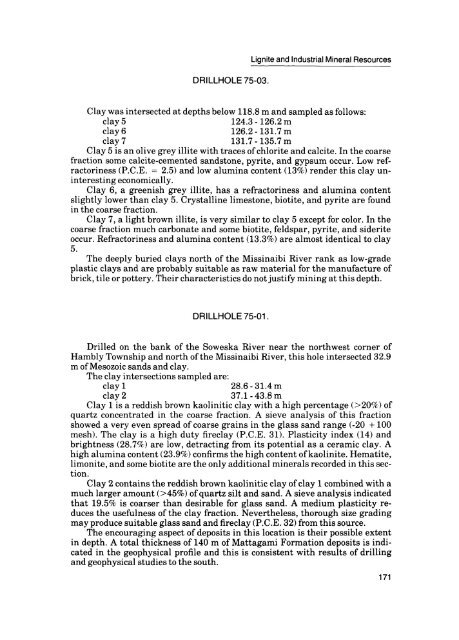Moose River Basin: geology and mineral potential - Geology Ontario
Moose River Basin: geology and mineral potential - Geology Ontario
Moose River Basin: geology and mineral potential - Geology Ontario
You also want an ePaper? Increase the reach of your titles
YUMPU automatically turns print PDFs into web optimized ePapers that Google loves.
DRILLHOLE 75-03.<br />
Lignite <strong>and</strong> Industrial Mineral Resources<br />
Clay was intersected at depths below 118.8 m <strong>and</strong> sampled as follows:<br />
clay 5<br />
124.3-126.2 m<br />
clay 6<br />
126.2-131.7 m<br />
clay?<br />
131.7-135.7 m<br />
Clay 5 is an olive grey illite with traces of chlorite <strong>and</strong> calcite. In the coarse<br />
fraction some calcite-cemented s<strong>and</strong>stone, pyrite, <strong>and</strong> gypsum occur. Low ref<br />
ractoriness (P.C.E. - 2.5) <strong>and</strong> low alumina content (13*26) render this clay un<br />
interesting economically.<br />
Clay 6, a greenish grey illite, has a refractoriness <strong>and</strong> alumina content<br />
slightly lower than clay 5. Crystalline limestone, biotite, <strong>and</strong> pyrite are found<br />
in the coarse fraction.<br />
Clay 7, a light brown illite, is very similar to clay 5 except for color. In the<br />
coarse fraction much carbonate <strong>and</strong> some biotite, feldspar, pyrite, <strong>and</strong> siderite<br />
occur. Refractoriness <strong>and</strong> alumina content (13.39k) are almost identical to clay<br />
5.<br />
The deeply buried clays north of the Missinaibi <strong>River</strong> rank as low-grade<br />
plastic clays <strong>and</strong> are probably suitable as raw material for the manufacture of<br />
brick, tile or pottery. Their characteristics do not justify mining at this depth.<br />
DRILLHOLE 75-01.<br />
Drilled on the bank of the Soweska <strong>River</strong> near the northwest corner of<br />
Hambly Township <strong>and</strong> north of the Missinaibi <strong>River</strong>, this hole intersected 32.9<br />
m of Mesozoic s<strong>and</strong>s <strong>and</strong> clay.<br />
The clay intersections sampled are:<br />
clay l<br />
28.6-31.4 m<br />
clay 2<br />
37.l-43.8 m<br />
Clay l is a reddish brown kaolinitic clay with a high percentage ^209e) of<br />
quartz concentrated in the coarse fraction. A sieve analysis of this fraction<br />
showed a very even spread of coarse grains in the glass s<strong>and</strong> range (-20 ± 100<br />
mesh). The clay is a high duty fireclay (P.C.E. 31). Plasticity index (14) <strong>and</strong><br />
brightness (28.7*56) are low, detracting from its <strong>potential</strong> as a ceramic clay. A<br />
high alumina content (23.9*56) confirms the high content of kaolinite. Hematite,<br />
limonite, <strong>and</strong> some biotite are the only additional <strong>mineral</strong>s recorded in this sec<br />
tion.<br />
Clay 2 contains the reddish brown kaolinitic clay of clay l combined with a<br />
much larger amount ^45*?6) of quartz silt <strong>and</strong> s<strong>and</strong>. A sieve analysis indicated<br />
that 19.5*56 is coarser than desirable for glass s<strong>and</strong>. A medium plasticity re<br />
duces the usefulness of the clay fraction. Nevertheless, thorough size grading<br />
may produce suitable glass s<strong>and</strong> <strong>and</strong> fireclay (P.C.E. 32) from this source.<br />
The encouraging aspect of deposits in this location is their possible extent<br />
in depth. A total thickness of 140 m of Mattagami Formation deposits is indi<br />
cated in the geophysical profile <strong>and</strong> this is consistent with results of drilling<br />
<strong>and</strong> geophysical studies to the south.<br />
171

















